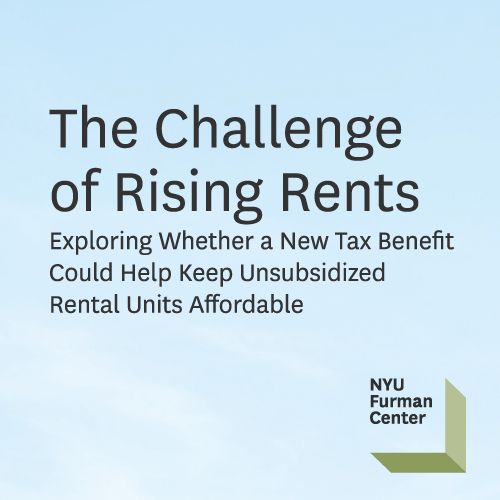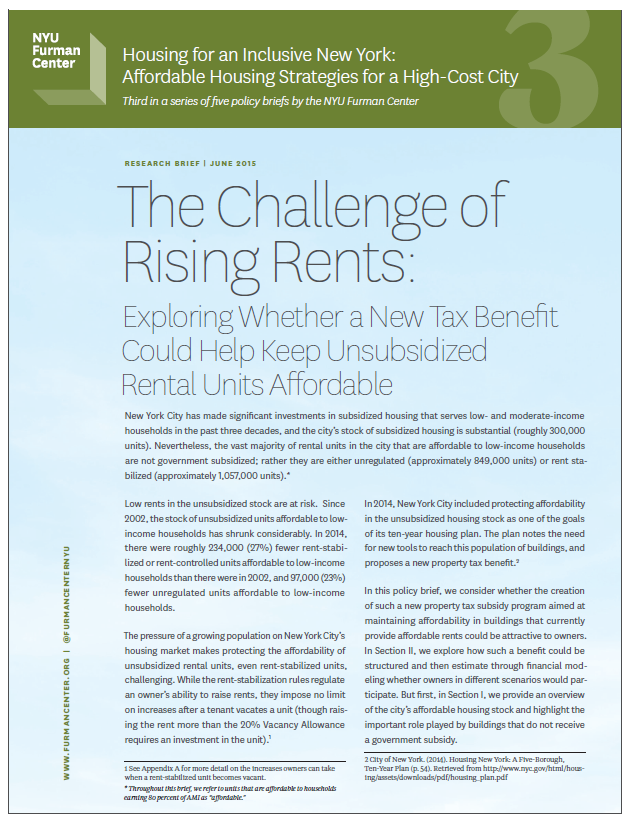
Report: The Challenge of Rising Rents

 A new report by the NYU Furman Center, titled The Challenge of Rising Rents: Exploring Whether a New Tax Benefit Could Help Keep Unsubsidized Rental Units Affordable (PDF), examines the importance of unsubsidized multifamily buildings as a source of low-rent housing in the city, and considers whether the city could offer a benefit to protect affordability in this stock.
A new report by the NYU Furman Center, titled The Challenge of Rising Rents: Exploring Whether a New Tax Benefit Could Help Keep Unsubsidized Rental Units Affordable (PDF), examines the importance of unsubsidized multifamily buildings as a source of low-rent housing in the city, and considers whether the city could offer a benefit to protect affordability in this stock.
The bulk of New York City’s housing stock that is affordable to low-income households (households earning 80% of the Area Median Income or $60,400 for a family of three in 2014) is in multifamily buildings that receive no government subsidy to maintain low rents. Rising rents threaten the future affordability of this critical source of low-rent housing.
Reporting on just-released data from the New York City Housing and Vacancy Survey, conducted every three years by the Census Bureau, the report finds that the stock of unregulated units and rent-stabilized units affordable to low-income households declined significantly during the last decade.
Key findings from the report include:
- The vast majority of New York City’s rental units are unsubsidized; nearly half (47%) of the city’s rental housing stock is rent stabilized.
In 2014, 47% (1,056,957 units) of New York City’s rental housing stock were rent stabilized or rent controlled, while 39% of rental units (848,721 units) were unregulated (not governed by any government restrictions on rents or tenant incomes). Government-subsidized units—including public housing—made up the remaining 13% of the city’s rental units (278,618 units).
- Most of the city’s rental units that are affordable to low-income households are not government subsidized; rather they are either unregulated or rent stabilized.
In 2014, the city had roughly 1.8 million unsubsidized rental units. Of these, about 53% (946,000 units) were affordable to households earning 80% AMI (about 617,000 rent-stabilized units and 329,000 unregulated units). In addition, roughly 10% (177,000 units) of unsubsidized rental units were affordable to households earning 50% AMI, and about 2% (41,000 units) were affordable to households earning 30% AMI.
- Between 2002 and 2014, the number unsubsidized units affordable to low-income households declined by over 330,000 units.
Between 2002 and 2014, the number of rent-stabilized units affordable to low-income households fell by 233,931 units (27%). During that same period, the stock of unregulated units affordable to low-income households declined by 96,595 units (23%). Between 2011 and 2014, the stock of affordable unsubsidized units decreased by approximately 124,000 units (85,000 from the rent stabilized stock and 39,000 from the unregulated stock).
- The city might achieve its goal of protecting affordability in the unsubsidized stock by offering a tax benefit to owners of currently affordable units if they agree to forgo some future rent increases.
Whether an owner would participate depends on her belief about future rent growth in her neighborhood. Whether it is worthwhile for the city to offer such a benefit depends on the city’s projections about future rent growth. The city may also wish to limit to the program to units that currently provide rents affordable to low-income households and to owners who agree to income restrictions for new tenants upon turnover.
This policy brief is third in the five-part series, titled, Housing for an Inclusive New York: Affordable Housing Strategies for a High-Cost City. The series includes:
- Creating Affordable Housing Out of Thin Air: The Economics of Mandatory Inclusionary Zoning in New York City
- Building New or Preserving the Old? The Affordable Housing Tradeoffs of Developing on NYCHA Land
- The Challenge of Rising Rents: Exploring Whether a New Tax Benefit Could Help Keep Unsubsidized Rental Units Affordable
View the press release (PDF).


